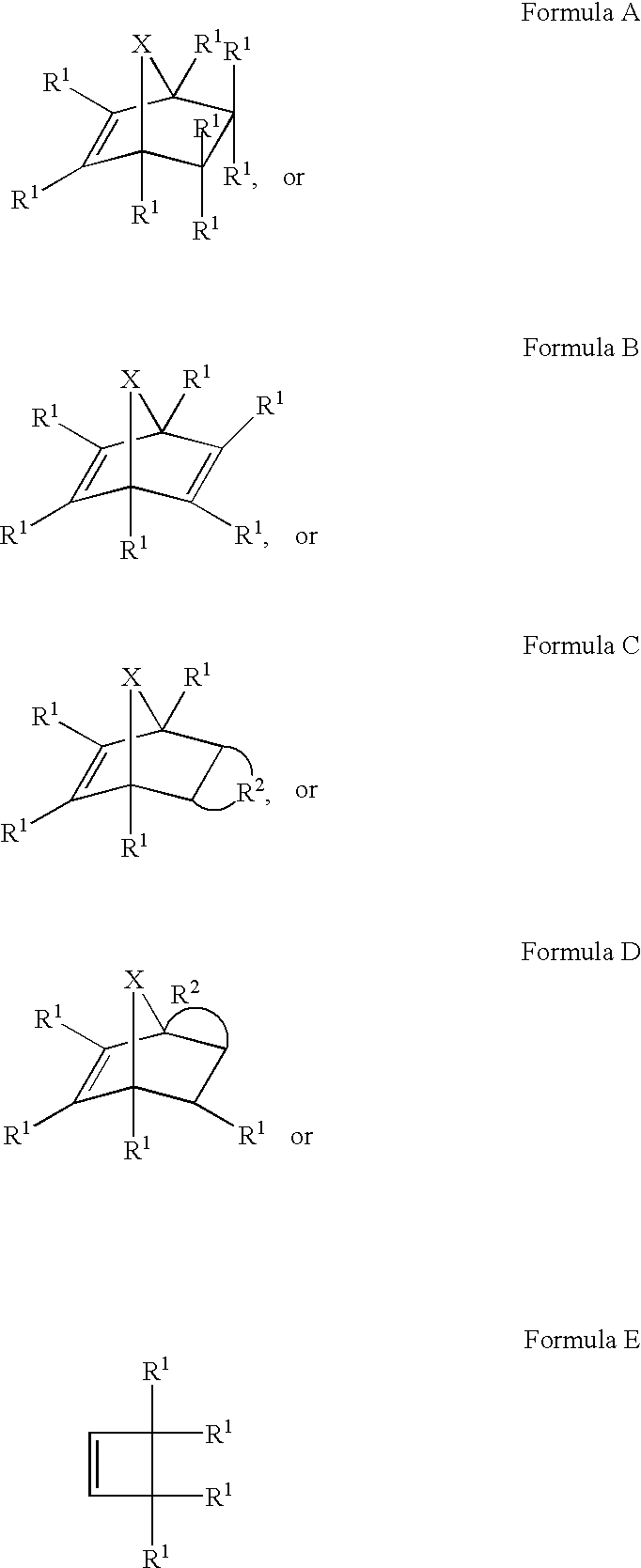Metathesis polymerization adhesives and coatings
a technology of adhesives and coatings, applied in the direction of adhesives, electrical equipment, pretreatment surfaces, etc., can solve the problems of difficult development of environmentally acceptable adhesives and coatings, and difficult to meet the requirements of the application. achieve remarkable bonding or adhesion strength, and easy us
- Summary
- Abstract
- Description
- Claims
- Application Information
AI Technical Summary
Benefits of technology
Problems solved by technology
Method used
Image
Examples
examples 1 and 2
[0113] A two-part adhesive system was made with the following ingredients:
1 Part A: Part B: ENB 40.6% RuCl.sub.2(PCy.sub.3).sub.2.dbd.CHPh 15.5% NBD 40.6% Paraffin oil 84.5% Styrene-isoprene elastomer 14.3% Silica 4.5%
[0114] Example 2 had the same ingredients as listed above except that Part B consisted of 7.7% RuCl.sub.2(PCy.sub.3).sub.2=CHPh and 92.3% paraffin oil. Two sets of lap shear samples from untreated polypropylene were prepared using Example 1 (5 mil width bond line and 10 mil width bond line) and one set was prepared using Example 2 (10 mil width bond line). All samples cured in about 10 seconds and formed an adhesive bond. The test results were as follows:
2 Example 1 (10 mil) Mean stress break--96 psi Adhesive failure mode Example 1 (5 mil) Mean stress break--94 psi Adhesive failure mode Example 2 (10 mil) Mean stress break--106 psi Adhesive failure mode
examples 3-11
[0115] Part A of a two-part adhesive system was made with the following ingredients:
3 ENB 45% NBD 30% Styrene-isoprene elastomer 15% Glass beads 8% Silica 4.5%
[0116] Part B was made with following ingredients in weight percents shown in the table below. The mean stress at break results of lap shear samples made with untreated polypropylene substrates are also provided in the table.
4 Ingredient / Ex. No. 3 4 5 6 7 8 9 10 11 RuCl.sub.2 (PCy.sub.3).sub.2.dbd.CHPh 4.1 2.9 2.2 1.6 0.7 2.1 1.6 7.7 0.7 Cyclohexene 77 78 78 80 80 47 48 0 0 Cyclopentene 0 0 0 0 0 47 48 92 95 Silica 4 4 4 2 4 4 2 0 4 Styrene-isoprene 15 15 16 16 16 0 0 0 0 Mean stress (psi) 224 128 100 11 7 4 11 232 7
examples 12 and 13
[0117] Part A is the same as in Examples 3-11, but for Example 12 part B consists of 2.5% tricyclohexylphosphine(1,3-dimesityl-4,5-dihydroimidazol--2-ylidene)benzylidene ruthenium dichloride catalyst, 92.5% cyclohexene, and 5.0% silica and for Example 13 part B consists of 1.2% tricyclohexylphosphine(1,3-dimesityl-4,5-dihydroimidazol-2-ylidene)benzyl-idene ruthenium dichloride catalyst, 93.8% cyclohexene and 5.0% silica. Polypropylene-substrate lap-shear samples for Example 12 had a mean stress at break of 419 psi and Example 13 had a mean stress at break of 32 psi.
PUM
| Property | Measurement | Unit |
|---|---|---|
| Angle | aaaaa | aaaaa |
| Viscosity | aaaaa | aaaaa |
| Time | aaaaa | aaaaa |
Abstract
Description
Claims
Application Information
 Login to View More
Login to View More - R&D
- Intellectual Property
- Life Sciences
- Materials
- Tech Scout
- Unparalleled Data Quality
- Higher Quality Content
- 60% Fewer Hallucinations
Browse by: Latest US Patents, China's latest patents, Technical Efficacy Thesaurus, Application Domain, Technology Topic, Popular Technical Reports.
© 2025 PatSnap. All rights reserved.Legal|Privacy policy|Modern Slavery Act Transparency Statement|Sitemap|About US| Contact US: help@patsnap.com



